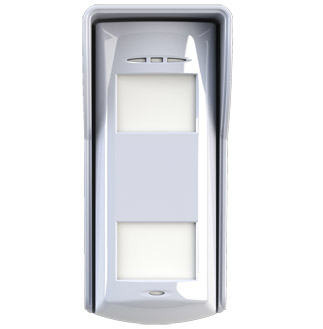The new external detection device from Pyronix, the XDL12TT-AM, has two independent Passive Infrared (PIR) sensors and one microwave sensor, offering what the product firm calls Tri-Technology (TT). The detector uses Tri-Signal Detection Logic to identify the presence of an intruder. This provides it’s claimed reliable and stable external detection as all three sensors must be activated sequentially in quick succession to create an alarm. This enhances the detector’s immunity to wind or other weather disturbances and limits the risk of false alarms,the manufacturer adds.
Each PIR sensor of the detector has its own dedicated volumetric field of view. The top PIR detects outwards and up, while the bottom PIR detects outwards and down, without overlapping. This set-up, alongside Tri-Signal Detection Logic, delivers sequential detection and increases its tolerance to pet immunity, the makers say.
So, should any large dog or cat stray into the coverage plane, it would only be picked up by the bottom PIR and the microwave sensors and therefore an alarm condition would not be activated. However, the lens coverage of the PIRs are angled so that any human will be detected walking through both PIR coverage planes. Therefore, as all three sensors are activated, so would an alarm condition.
As for changing conditions and swaying vegetation, the XDL12TT-AM features Anti-Sway Analytics. This digital filter distinguishes between the movements of trees and plants from that of an intruder. The detector also has IP55 weatherproof rating, polycarbonate plastics and fully sealed optics. It has been moulded with a stabilising material to prevent discolouration over time.
The product also features Anti-Masking, which is a Grade 3 patented technology to protect against any attempt to mask any of the three sensors with cardboard, duct tape, sprays, lacquers or aluminium foil. It also consists of Anti-Blocking, which is a Grade 4 technology that prevents the system from being armed if there is anything blocking the vision of any of the sensors. So, to arm the system, whatever is blocking the detector from detecting needs to be removed first.
Providing either volumetric or curtain coverage to suit the area that needs protecting, each lens can also be masked to restrict the coverage area. This is the manufacturer says of use in areas where busy roads can cause false alarms. The detector also uses three frequency bands to avoid any interference (cross-talk) that can occur when two or more detectors with the same frequency band are installed close to each other. This also allows multiple to be fitted in close proximity of each other, including the use of a fixed bracket, enabling two to be fitted back to back, providing 24m range with 180 degree volumetric coverage.










